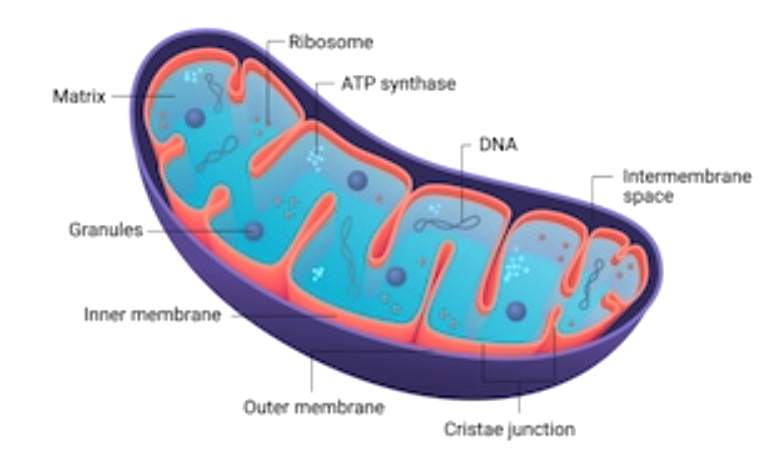
The inner membrane of mitochondria is folded because
a) It has no space
b) It helps in transportation of material
c) It increases the surface area
d) It stores more food
Answer
587.7k+ views
Hint:
- Mitochondria are membrane-bound organelles, but with two different membranes.
- The powerhouse of our cell mitochondria has an external film and inward layer. The internal layer known as the cristae is collapsed.
Complete answer:
To answer this question we need the knowledge of basic structure of mitochondria

Mitochondrion structure
- The folds of the internal layer or the cristae give an expansion in the surface area which gives the mitochondrion more areas for ATP creation to happen. Actually, without them the mitochondrion would not have the option to stay aware of the cell's ATP needs.
- The folds (cristea) of the mitochondria give a more noteworthy surface territory (more space) for the concoction responses of oxidative phosphorylation (procedure of changing over food sugars into vitality (ATP)) to happen.
- Expanded surface region permits more proteins that make the electron transport anchor during this procedure to work at making more ATP. More space implies more vitality manufacturing plants in every mitochondrion and more vitality to fuel our organs and frameworks to support life.
- The purpose behind them is to expand the surface region of the mitochondrial inside, which makes more space for a bigger number of oxidative chemicals. That gives the mitochondrion an immeasurably more noteworthy limit with respect to ATP generation.
Therefore, the answer is c, it increases the surface area.
Additional information:
- Some cells have different amounts of mitochondria due to their energy needs such as muscles, liver, kidney to name a few.
- Mitochondrial DNA is inherited only from the mother.
Note: Mitochondria are free-floating cell organelles! Chemical energy produced by mitochondria is stored in a small molecule called adenosine triphosphate.
- Mitochondria are membrane-bound organelles, but with two different membranes.
- The powerhouse of our cell mitochondria has an external film and inward layer. The internal layer known as the cristae is collapsed.
Complete answer:
To answer this question we need the knowledge of basic structure of mitochondria

Mitochondrion structure
- The folds of the internal layer or the cristae give an expansion in the surface area which gives the mitochondrion more areas for ATP creation to happen. Actually, without them the mitochondrion would not have the option to stay aware of the cell's ATP needs.
- The folds (cristea) of the mitochondria give a more noteworthy surface territory (more space) for the concoction responses of oxidative phosphorylation (procedure of changing over food sugars into vitality (ATP)) to happen.
- Expanded surface region permits more proteins that make the electron transport anchor during this procedure to work at making more ATP. More space implies more vitality manufacturing plants in every mitochondrion and more vitality to fuel our organs and frameworks to support life.
- The purpose behind them is to expand the surface region of the mitochondrial inside, which makes more space for a bigger number of oxidative chemicals. That gives the mitochondrion an immeasurably more noteworthy limit with respect to ATP generation.
Therefore, the answer is c, it increases the surface area.
Additional information:
- Some cells have different amounts of mitochondria due to their energy needs such as muscles, liver, kidney to name a few.
- Mitochondrial DNA is inherited only from the mother.
Note: Mitochondria are free-floating cell organelles! Chemical energy produced by mitochondria is stored in a small molecule called adenosine triphosphate.
Recently Updated Pages
The number of solutions in x in 02pi for which sqrt class 12 maths CBSE

Write any two methods of preparation of phenol Give class 12 chemistry CBSE

Differentiate between action potential and resting class 12 biology CBSE

Two plane mirrors arranged at right angles to each class 12 physics CBSE

Which of the following molecules is are chiral A I class 12 chemistry CBSE

Name different types of neurons and give one function class 12 biology CBSE

Trending doubts
One Metric ton is equal to kg A 10000 B 1000 C 100 class 11 physics CBSE

Explain zero factorial class 11 maths CBSE

What is 1s 2s 2p 3s 3p class 11 chemistry CBSE

Discuss the various forms of bacteria class 11 biology CBSE

State the laws of reflection of light

Difference Between Prokaryotic Cells and Eukaryotic Cells




